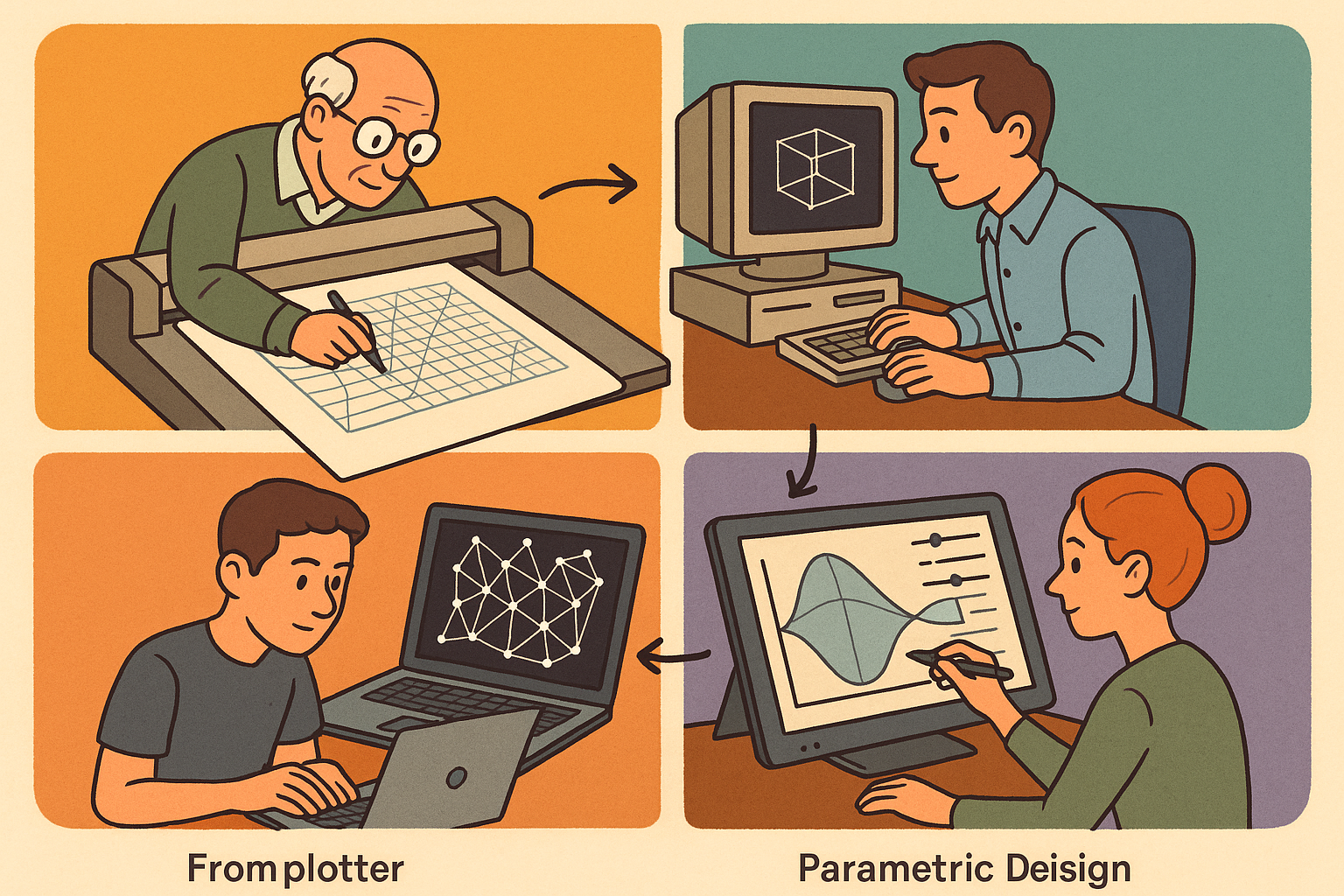Your Cart is Empty
Customer Testimonials
-
"Great customer service. The folks at Novedge were super helpful in navigating a somewhat complicated order including software upgrades and serial numbers in various stages of inactivity. They were friendly and helpful throughout the process.."
Ruben Ruckmark
"Quick & very helpful. We have been using Novedge for years and are very happy with their quick service when we need to make a purchase and excellent support resolving any issues."
Will Woodson
"Scott is the best. He reminds me about subscriptions dates, guides me in the correct direction for updates. He always responds promptly to me. He is literally the reason I continue to work with Novedge and will do so in the future."
Edward Mchugh
"Calvin Lok is “the man”. After my purchase of Sketchup 2021, he called me and provided step-by-step instructions to ease me through difficulties I was having with the setup of my new software."
Mike Borzage
Parametric Design Evolution: From Static CAD to Intelligent Modeling
August 24, 2025 8 min read


Overview of Parametric Design
Parametric design has evolved considerably over the decades, transitioning from early CAD systems that relied on static geometries to modern platforms that emphasize adaptability and intelligent modeling. This evolution traces back to the initial development of computer-aided drafting software, where designers manually input geometric constraints to generate flows of information. Over time, the integration of algorithmic processes and **flexible design workflows** transformed these early systems into dynamic environments that support real-time parameter adjustments and iterative design refinements. These systems now empower designers with the ability to interact with models that can update automatically based on changes in input parameters. In the early days, designers were constrained by the lack of interactive capabilities and were limited to producing fixed results even if modifications were required. With the introduction of parametric techniques, the workflow shifted from a linear drafting process to one of continuous evolution and dynamic refinement.
Historic Foundations and Technological Milestones
The journey began with simple CAD programs that provided users with the ability to draw and adjust simple shapes on a computer screen. Early on, these systems played a vital role in establishing a digital framework for design, but they lacked the sophistication needed for complex assemblies or real-time modifications. As computational power increased and algorithms became more refined, developers integrated advanced routines such as geometric constraints, allowing designs to be altered without the need for complete redrafting. Essential milestones included the introduction of solids modeling and the advent of constraint-based modeling environments. Additionally, the infusion of iterative design strategies encouraged designers to explore multiple design possibilities without losing control over the underlying model parameters.Core Concepts and Flexibility in Workflows
At its essence, parametric design is founded on the idea of attributes, constraints, and relationships that govern the behavior of objects within a design system. In this context, designers can establish rules where the modification of one element automatically prompts a recalculation or adjustment in related features, thereby ensuring consistency and structural integrity throughout the model. The concept of **flexibility and adaptability in design workflows** has been a driving force behind the evolution of these systems. This flexibility enables engineers and architects to incorporate modifications quickly, maintain precision, and reduce rework. It also serves as a bridge between creative exploration and engineering feasibility. Some notable advantages include:- Improved efficiency through automatic adjustments.
- Enhanced design integrity through maintained constraints.
- Facilitated experimentation without jeopardizing consistency.
- Better integration with manufacturing and simulation processes.
Advanced Features in Modern Parametric Software Suites
Modern parametric software packages have incorporated a range of sophisticated features that significantly enhance the design process. Among these are **dynamic constraint solving** and the ability to adjust parameters in real time, which empower users to refine intricate designs on the fly. These systems have moved away from the limitations of static geometries and now offer continuous computational analyses that provide immediate feedback. Such capabilities allow designers to predict downstream effects of design modifications, ensuring a seamless workflow where theoretical exploration meets practical application. Advanced integration with simulation tools further supports stress analysis, fluid dynamics, and performance prediction by embedding computational fluid dynamics (CFD) or finite element analysis (FEA) directly within the design environment. This integration not only improves the accuracy of designs but also accelerates the iterative process by reducing the need to switch between disparate software platforms.
Key Features and Their Impact
The most influential features of these modern suites include:- Dynamic Constraint Solving: Enabling designs to update in real time with parameter changes, ensuring consistency.
- Simulation Integration: Embedding simulation tools that facilitate stress testing and performance assessments within the design process.
- Complex Assembly Management: Providing robust support for managing large and intricate assemblies with interdependent components.
- Enhanced Visualization Techniques: Bridging the gap between design intentions and final product rendering via advanced rendering engines.
Visualization and Interoperability Considerations
Another noteworthy improvement in these software suites is in the area of enhanced visualization. High-resolution, photorealistic rendering tools allow designers to evaluate both aesthetic and engineering details in a unified space. Moreover, **data interoperability between different software environments** has become a cornerstone of modern parametric design. This ensures seamless transitions of data between CAD systems, simulation platforms, and manufacturing tools. Users now benefit from a holistic approach where the visualization process not only aids in communication but also informs decision-making. The emphasis on these advanced features represents a significant shift in how design software is used, evolving from a tool for drafting to a fully integrated environment that covers conceptualization, simulation, and final product presentation.Future Trends and Innovations in Parametric Design
As the field of parametric design continues to mature, new trends and innovations are emerging that promise to reshape the landscape of design and engineering. A major development on the horizon is the incorporation of **AI and machine learning algorithms** to predict design outcomes and optimize parameters automatically. The infusion of artificial intelligence into design software is not simply a buzzword; it represents a profound shift towards predictive modeling and smart diagnostics. These algorithms can learn from previous iterations to suggest optimal modifications, immobilizing human error and expediting the design process. Additionally, the advent of cloud-based collaboration tools facilitates real-time multi-user modifications, thus enabling a distributed design team to work simultaneously on a single model, regardless of geographic location.
Emerging Technologies in Parametric Design
Moving forward, several cutting-edge technologies are anticipated to further enhance the parametric design ecosystem:- Artificial Intelligence and Machine Learning: Utilized for predictive design adjustments and automated optimization based on historical data.
- Cloud-Based Collaboration: Enabling multiple users to interact with a single model in real time, promoting global teamwork and concurrent problem-solving.
- Virtual and Augmented Reality: Providing immersive environments for interactive design reviews where designers experience their modeled structures in simulated physical contexts.
- Hardware Accelerated Performance: Emerging hardware, particularly **GPU acceleration**, is set to revolutionize real-time computation, resulting in more complex and high-fidelity simulations.
Collaborative and Immersive Design Environments
Future trends are as much about integrating sophisticated algorithmic processes as they are about fostering a collaborative environment. The breakdown of geographical and disciplinary barriers through cloud-based systems and the immersive aspects of VR and AR mean that design teams can make decisions more rapidly and with increased confidence. The benefits of such integrations are multifold:- Acceleration of project timelines through real-time communication and simultaneous design modifications.
- Reduction in error margins thanks to advanced predictive algorithms that reduce manual guesswork.
- Enhanced qualitative and quantitative assessments of design iterations in immersive environments.
- Streamlined workflows with hardware improvements that increase simulation speeds and visual accuracy.
Challenges and Opportunities in Implementing Advanced Parametric Features
The adoption of advanced parametric software features brings with it a set of inherent challenges and significant opportunities. One of the foremost challenges is addressing the steep learning curve associated with these sophisticated tools. New users often require extensive training to master the multifaceted interfaces and functionalities that modern parametric design software offers. This is compounded by the need for continual updates and iterative improvements to the interface, where intuitiveness must go hand in hand with enhanced capability. The trade-off between customization and standardization further complicates the process. To cater to different project scales and industries, software must be flexible enough to allow for deep customization while still offering standardized workflows that facilitate efficiency and consistency.
Key Implementation Challenges
Some of the main challenges include:- Addressing the learning curve through robust training programs and intuitive user interface designs.
- Balancing the degree of customization with the need for standardization across diverse industry applications.
- Managing complex workflows where data interoperability is critical to ensure seamless transitions between design, simulation, and manufacturing software.
- Ensuring that the integration of new hardware capabilities does not disrupt the existing workflow.
Opportunities for Diverse Industries
The opportunities presented by these advanced tools are particularly salient in sectors such as architecture, product design, and engineering. In architecture, parametric design enables the exploration of complex geometries while maintaining structural integrity and compliance with regulatory standards. In product design, rapid iterations can lead to more efficient prototyping and improved performance metrics. Engineers benefit from the tight integration of simulation data, ensuring that models reflect real-world behaviors under varying conditions. Moreover, designers can leverage opportunities such as:- Streamlining the design-to-manufacturing process by integrating simulation and visualization tools.
- Improving the precision of complex assemblies through real-time data synchronization between different software platforms.
- Reducing overall project lead times by adopting cloud-based collaboration and parameter optimization techniques.
- Capitalizing on new hardware advancements, including **GPU acceleration**, to handle high-fidelity computations efficiently.
Conclusion
In summary, the integration of advanced features into modern parametric design software is having a transformative effect on creative and engineering workflows. The evolution from early CAD systems to sophisticated current-day suites has laid the groundwork for a future where **dynamic constraint solving**, simulation integration, and enhanced visualization work hand in hand with emerging technological trends, such as cloud-based collaboration and **GPU acceleration**. The adoption of these innovations simultaneously presents challenges like steep learning curves and data interoperability issues, as well as numerous opportunities for growth and efficiency in various disciplines.
As the landscape of parametric design continues to shift, embracing these advanced techniques is becoming increasingly vital for any design professional aiming to maintain a competitive edge. The promising integration of AI, machine learning, and immersive virtual technologies heralds a future where design and engineering processes will be even more dynamic and responsive. Designers and engineers are encouraged to engage with these rapid advancements, leveraging them not only to drive efficiency and accuracy in their current projects but also to pioneer new breakthroughs in creative expression and technical performance. Ultimately, the forward momentum of parametric design innovation will continue to empower industry professionals to realize more complex, high-caliber solutions, thereby reshaping the way products, structures, and systems are conceived and brought to life.
Also in Design News

Design Software History: From Plotters to Procedural Intent: A Technical History of Generative and Parametric Design Software
January 04, 2026 13 min read
Read More
Semantic Meshes: Enabling Analytics-Ready Geometry for Digital Twins
January 04, 2026 12 min read
Read MoreSubscribe
Sign up to get the latest on sales, new releases and more …



